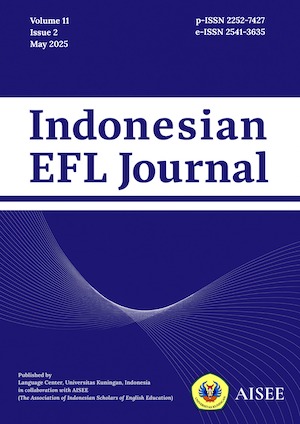GENDER DIFFERENCES IN TEACHER QUESTIONING STRATEGIES: A CASE STUDY AT SMKS PASUNDAN 1 CIANJUR
Abstract
This study investigates the questioning strategies of male and female English teachers in EFL classrooms at SMKS Pasundan 1 Cianjur. Using a qualitative descriptive method and a case study approach, data were collected through observations, questionnaires, and interviews. The findings reveal that both genders use diverse questioning strategies to enhance classroom interaction, incorporating questions at the beginning, middle, and end of lessons. Furthermore, both genders use three main types of questions: procedural, convergent, and divergent. However, significant differences exist in the frequency and types of questions used. This research highlights how gender dynamics influence teaching methods and student engagement, providing valuable insights for improving EFL education.
Keywords: Teacher’s Questions; Types of Questioning Strategies; Classroom Interaction; EFL Classroom; Dender Differences
References
Angouri, J., & Baxter, J. (2021). Gender and Sexual Orientation as Social Categories: Exploring Identity Complexity. Journal of Social Psychology, 45(3), 321-335.
Astrid, P., et al. (2019). Teachers' Utilization of Various Question Types in EFL Classrooms to Enhance Student Proficiency and Facilitate Effective Teaching. Journal of Language Teaching and Learning, 9(3), 102-115.
Bloom, B. S. (1956). Taxonomy of Educational Objectives: The Classification of Educational Goals. Longmans, Green & Co.
Brown, H. D. (2000). Teaching by Principles: An Interactive Approach to Language Pedagogy (2nd ed.). Longman.
Brualdi, A. C. (1998). Classroom Questions: Practical Assessment, Research & Evaluation. Practical Assessment, Research & Evaluation, 6(6). Retrieved from http://pareonline.net/getvn.asp?v=6&n=6
Cantikka, M. V., Vinca, M., Hidayat, C., Nurjanah, S., & Maolida, E. H. (2020). Teaching Practicum of Pre-Service Teachers in EFL Classrooms: Questioning Types and Purposes. Journal of Teaching & Learning English in Multicultural Contexts (TLEMC) 4(1). 25-33 http://jurnal.unsil.ac.id/index.php/tlemc/index
Chaudron, C. (1988). Second Language Classrooms: Research on Teaching and Learning. Cambridge University Press.
Coates, J. (2013). Gender and Language in Interaction. Routledge.
Cotton, K. (2003). Classroom Questioning: School Improvement Research Series. Portland, OR: Northwest Regional Educational Laboratory
Cotton, K. (2007). Classroom Questioning. Paper presented in North West Regional Education laboratory, Kansas
Eble, K. E. (1988). The Craft of Teaching: A Guide to Mastering the Professor's Art. San Francisco: Jossey-Bass.
Erianti, A., Akib, E., & Baso, F. A. (2018). An analysis of teachers’ questioning strategies in ELT (English Language Teaching) the classroom interaction at eleventh grade SMA Muhammadiyah 1 UNISMUH Makassar. Exposure Journal, 7(1), 58–70.
Farahian, M., & Rezaee, A. (2012). Categorization of Teacher Questions: Exploring Open and Closed, Display and Referential, and Yes/No Questions. Journal of Educational Psychology, 14(2), 87-98.
Gaither, G. (2008). The Role of Questioning in Teaching and Learning. Jossey-Bass.
Gray, J. (2020). Women's Language: Emotionality Versus Intelligence. Gender Studies Journal, 18(2), 145-158.
Humm, M. (1990). Feminism and Gender Theory. Continuum.
Lakoff, R. (1975). Language and Women's Place. Harper & Row.
Maolida, E. H. (2013). The influence of teacher’s instructional objectives on variations of exchange patterns in an EFL classroom. Indonesian Journal of Applied Linguistics, 3(1), 68–80. DOI: 10.17509/ijal.v3i1.661.
Milawati, & Suryati, N. (2019). EFL teacher's oral questioning: Are her questions and strategies effective? Dinamika Ilmu, 19(1), 37-55.
Nashruddin, N., Rahmawati Ningtyas, P. (2020). English as Foreign Language (EFL) Teacher’s Questioning Strategies in Classroom Interaction. The journal of Ultimate Research and Trends in Education (Vol. 2, Issue 1). 5-11 https://journal.unilak.ac.id/index.php/UTAMAX/
Ningsih, A. R., Erlina, D., & Amrina, R. D. (2021). English Teacher’s Questioning Strategy in EFL Classroom Interaction. Jadila: Journal of Development and Innovation in Language and Literature Education, 1(4), 478-499.
Piaget, J. (1973). To Understand is to Invent: The Future of Education. Grossman.
Richards, J. C., & Lockhart, C. (1996). Reflective Teaching in Second Language Classrooms.Cambridge, New York: Cambridge University Press.
Suartini, N. K. T., Wedhanti, N. K., & Suprianti, G. A. P. (2020). Teacher’ s Questioning Strategies in Junior High School: A Case Study. Jurnal Pendidikan Bahasa Inggris Undiksha, 8(2), 97–103
Talbot, M. (2010). Language and Gender (2nd ed.). Polity Press.
Vygotsky, L. S. (1978). Mind in Society: The Development of Higher Psychological Processes. Harvard University Press.
Weatherall, A., (2003) Gender, language and discourse. Routledge.
West, C., & Zimmerman, D. H. (1987). Doing Gender. Gender & Society, 1(2), 125-151.
Winnie. (1994). The Role of Different Question Types in Improving Classroom Interaction and Student Communication. Journal of Educational Psychology, 20(3), 321-3









